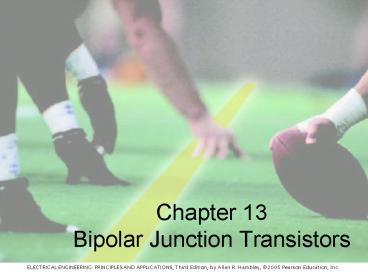Chapter 13 Bipolar Junction Transistors - PowerPoint PPT Presentation
1 / 64
Title:
Chapter 13 Bipolar Junction Transistors
Description:
Except for reversal of current directions and voltage polarities, the pnp BJT is almost identical to the npn BJT. Title: No Slide Title Author: U95-2 Last modified by: – PowerPoint PPT presentation
Number of Views:326
Avg rating:3.0/5.0
Title: Chapter 13 Bipolar Junction Transistors
1
Chapter 13Bipolar Junction Transistors
2
Chapter 13Bipolar Junction Transistors
1. Understand bipolar junction transistor
operation in amplifier circuits. 2. Analyze
simple amplifiers using the load-line
technique and understand the causes of
nonlinear distortion.
3
3. Use large-signal equivalent circuits to
analyze BJT circuits. 4. Analyze bias
circuits. 5. Use small-signal equivalent
circuits to analyze BJT amplifiers. 6.
Compute performance of several important
amplifier configurations. 7. Select an amplifier
configuration appropriate for a given
application.
4
(No Transcript)
5
(No Transcript)
6
Equations of Operation
7
(No Transcript)
8
9
COMMON-EMITTER CHARACTERISTICS
10
(No Transcript)
11
Common-emitter Input Characteristic
12
Common-emitter Output Characteristics
13
(No Transcript)
14
(No Transcript)
15
(No Transcript)
16
LOAD-LINE ANALYSIS OF A COMMON-EMITTERAMPLIFIER
(Input Circuit)
17
LOAD-LINE ANALYSIS OF A COMMON-EMITTERAMPLIFIER
(Output Circuit)
18
(No Transcript)
19
(No Transcript)
20
(No Transcript)
21
(No Transcript)
22
When iC becomes zero, we say that the transistor
is cutoff. When vCE 0.2 V, we say that the
transistor is in saturation.
23
PNP BIPOLAR JUNCTION TRANSISTORS
Except for reversal of current directions and
voltage polarities, the pnp BJT is almost
identical to the npn BJT.
24
(No Transcript)
25
(No Transcript)
26
(No Transcript)
27
(No Transcript)
28
(No Transcript)
29
LARGE-SIGNAL DC CIRCUIT MODELS(Active-Region
Model)
30
LARGE-SIGNAL DC CIRCUIT MODELS(Saturation-Region
Model)
31
LARGE-SIGNAL DC CIRCUIT MODELS(Cutoff-Region
Model)
32
Analysis of the Fixed Base Bias Circuit
33
(No Transcript)
34
(No Transcript)
35
(No Transcript)
36
(No Transcript)
37
(No Transcript)
38
(No Transcript)
39
(No Transcript)
40
(No Transcript)
41
Analysis of the Four-Resistor Bias Circuit
42
(No Transcript)
43
(No Transcript)
44
(No Transcript)
45
ib(t) denotes the signal current flowing into the
base, IBQ is the dc current that flows when the
signal is absent, and iB(t) is the total base
current. Similar notation is used for the other
currents and voltages.
46
(No Transcript)
47
(No Transcript)
48
Small-Signal Equivalent Circuit for the BJT
49
(No Transcript)
50
COMMON-EMITTER AMPLIFIERS
51
(No Transcript)
52
(No Transcript)
53
(No Transcript)
54
(No Transcript)
55
(No Transcript)
56
(No Transcript)
57
The common-emitter amplifier is inverting and has
large voltage gain magnitude, large current gain,
and large power gain.
58
EMITTER FOLLOWERS
59
(No Transcript)
60
(No Transcript)
61
(No Transcript)
62
Output Impedance
63
(No Transcript)
64
Even though the voltage gain of the emitter
follower is less than unity, the current gain and
power gain can be large.































